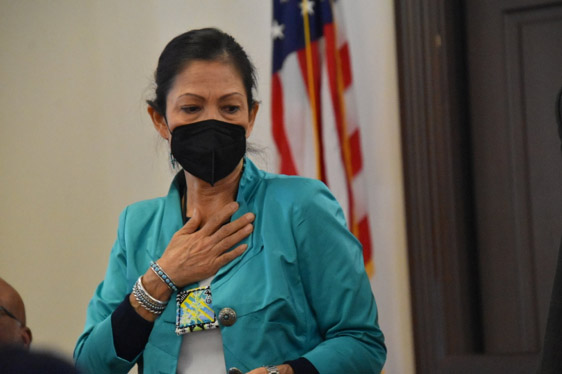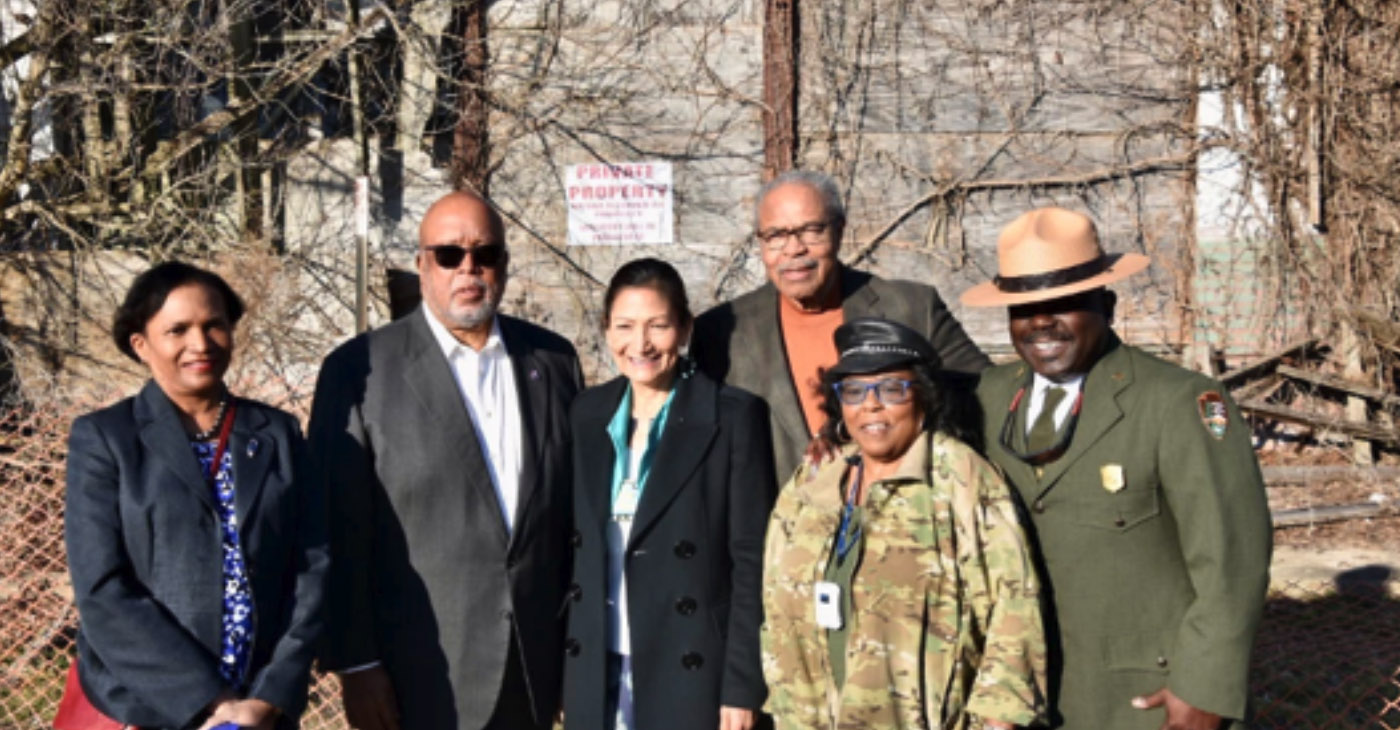New National Park Unit Discussed for the Delta; ETHIC, a Focal Point
By Gail H.M. Brown, Ph.D., Contributing Writer to The Mississippi Link
Hosted by U.S. Rep. Bennie Thompson, history-making Native American U.S. Secretary of Interior (DOI) Deb Haaland toured crucial civil rights sites of Mississippi, Tuesday, Feb. 15.
Appointed by the Biden-Harris Administration, Haaland made history when she became the first Native American to serve as a cabinet secretary.
Historically, the U.S. Department of the Interior, created March 3, 1849, is in charge of the Nation’s internal affairs. (https://www.doi.gov/whoweare/history).

Secretary Holland expresses gratitude to members participating in roundtable at the courthouse in Sumner, MS where the murder trial took place
Also joining Haaland on the tour was White House Council on Environmental Quality (CEQ) Chair Brenda Mallory, also a history-maker. The 12th chair of CEQ, Mallory is the first African American to serve in this position. As chair, she advises the President on environmental and natural resources policies that improve, preserve and protect public health and the environment for America’s communities.
Cassius Cash, deputy regional director, National Park Service (NPS), served as facilitator and guide.
The tour’s first stop was the now dilapidated, overgrown-with-vines Bryant’s Grocery, on Money Road, in Greenwood, Miss., where 14-year-old Emmett Till of Chicago was accused of allegedly whistling at the white store clerk.
“This is one of the most impactful stops for me personally,” said Cash, as he began the tour. “It took me a while to leave this spot. Just tried to put myself in the place of Emmett on the day that event started.” He then yielded to Thompson for welcoming remarks.
“First of all, Madam Secretary, we are glad to have you in the Second District,” Thompson said. “What you have with this situation is a lot of what happened in the south when people were trying to pursue freedom, justice and equality, and the brutality associated with it.”
“The story behind this, and a lot of stories like this, needs to be told as accurate as possible,” said Thompson. “We are glad that there is interest from the Park Service as well as from you being here; [which] says volumes for that interest.”
Following Thompson, Till’s cousin, Reverend Wheeler Parker Jr., who shared his first-hand knowledge of what happened that summer day in 1955 at the now barely recognizable Bryant Grocery.
Parker first reflected on his cousin Emmett growing up in Chicago as a “fun-loving guy; never had a dull day in his life.” Parker said that was part of the reason his mother and others did not want Emmitt to visit Mississippi as he so much wanted.
Parker stressed that “so many stories have been told about the incident that it is unbelievable.” He will be sharing his account in a book that is due out later this year.
The next stop was the Emmett Till Historic Intrepid Center (ETHIC) in Glendora, Miss., where Mayor Johnny Thomas, locals, state representatives and other dignitaries welcomed Haaland, Mallory, staff members and others.
State Representative Tracey Rosebud and Mississippi Transportation Commissioner Willie Simmons were also among Glendora’s welcome wagon.
Thompson praised the people of Glendora for putting “sweat equity” into developing what he called, “the house the community built in memory of young Till.”
It was at the ETHIC that Haaland began to share her sentiments that Native American history and Black history are American history. And “the complete story must be told,” she said.
“[We], Native Americans, weren’t even citizens of the United States until 1924, and we’d been here for millennia. We were here before the first Europeans came to this country,” Haaland said. “I feel like we are allies in the fight to make sure that our history is represented in the way that we feel it should be.”
She said that is where the National Park Service comes in. According to the DOI, The National Park Service is currently conducting a Special Resource Study of significant civil rights sites in Mississippi. Authorized by Congress in 2017, the study is designed to provide Congress with critical information used in the legislative process of designating a new unit.”
During the tour, citizens in Glendora made the case for the new National Park designation be there with the Till Center as the focus point.
Other sites on the tour included the Emmett Till Interpretive Center in Sumner, Miss., and the historic City of Mound Bayou where Mayor Leighton Aldridge invited practically all of the former mayors and others to welcome Secretary Haaland.
In Sumner, a round table discussion was held on the social injustice of the Till murder and its sparking impact on civil rights.
Roundtable panelist, Shiann McDanail, a 12th grader of West Tallahatchie High School, said, “I’m glad a curriculum [is being developed] for us to learn more about Emmett Till because in school, the teachers are not able to teach how they want to teach.” She is in favor of the National Park being there. “Just not for us but for other people and generations,” McDanail said.
“Who could we be if we don’t know our own history?”
The 12th-grader later told The Mississippi Link that to be honest, unfortunately some of her peers do not understand the importance of the Emmett Till story. “My generation should want to get together to help like kindergartners, six- and seven-graders, to understand what [went] on with Emmett and other people that left a historical mark on us today,” she said. “So, when they graduate high school, they will know and appreciate our history.”
McDanail aspires to become a teacher.
During the final stop at the historic Jackson, Miss. home of Medgar and Myrlie Evers, Haaland also stressed the importance of educating children about their history. “It’s important that we educate our children because they deserve to know the history of our country,” she said.
Haaland and entourage were warmly welcomed by the Evers’ daughter Reena Evers and Jackson Mayor Chokwe Antar Lumumba.
Having been donated to and preserved by Tougaloo College for many years, the Evers’ home, where Medgar was assassinated in his carport, is currently a National Monument since December 10, 2020. It is National Monument No. 423.
The post History-Making U.S. Secretary of Interior Tours Mississippi’s Civil Rights Sites first appeared on BlackPressUSA.

